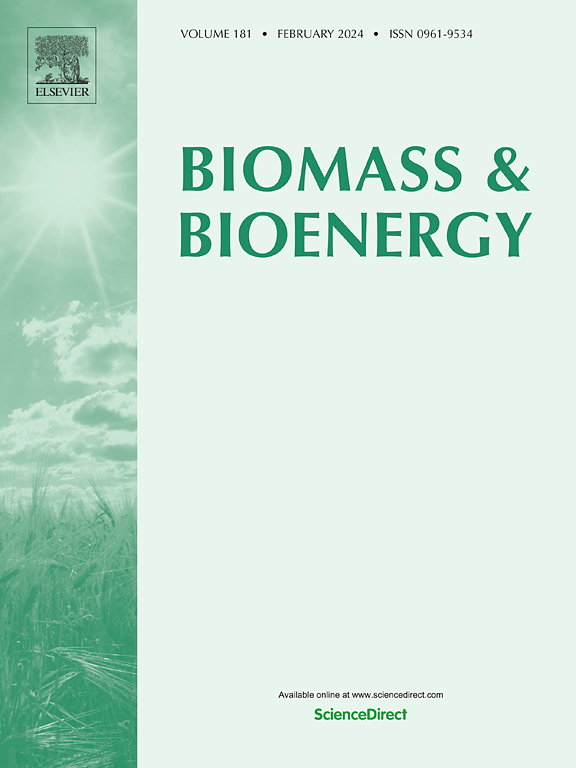Biomass gasification in an autothermal semi-industrial fluidized bed gasifier: Syngas characterization and energy balance
IF 5.8
2区 生物学
Q1 AGRICULTURAL ENGINEERING
引用次数: 0
Abstract
Biomass gasification is well-established in industrial applications, but semi-industrial autothermal systems remain underexplored despite their role as a bridge between laboratory scale and full-scale deployment. Understanding syngas characteristics, energy recovery, and system efficiency at this scale is critical for optimizing industrial gasification. This study examines air gasification of woody biomass in a 200 kW autothermal bubbling fluidized bed gasifier operating at equivalence ratios (ER) 0.22–0.45 with recorded bed temperatures of 695–860 °C. Key performance indicators, including syngas composition, lower heating values (LHV), cold gas efficiency (CGE), carbon conversion efficiency (CCE), and energy distribution of the near-industrial system, were analyzed. Results show syngas primarily contained H2 (6.4–11.3 %), CO (8.5–16.6 %), CH4 (3.0–5.5 %), and CO2 (15.6–19.4 %), with LHV of 3.9–7.1 MJ/Nm3. CGE reached 51.8–71.4 %, and CCE 78.6–98.5 %. Overall system efficiency (79–93 %) highlights the role of energy recovery from syngas cooling and gathered solid residues in improving large-scale gasification viability. This study provides novel insights into optimizing semi-industrial gasification, demonstrating the feasibility of integrated energy recovery for enhanced efficiency and sustainability.

生物质气化在工业应用中已得到广泛认可,但半工业自热系统尽管是实验室规模与全面部署之间的桥梁,却仍未得到充分探索。了解这种规模的合成气特性、能量回收和系统效率对于优化工业气化至关重要。本研究考察了木质生物质在 200 千瓦自热鼓泡流化床气化炉中的气化过程,该气化炉的等效比 (ER) 为 0.22-0.45,记录的床层温度为 695-860 ℃。对关键性能指标进行了分析,包括合成气成分、较低热值 (LHV)、冷气化效率 (CGE)、碳转化效率 (CCE) 以及近工业系统的能量分布。结果表明,合成气主要含有 H2(6.4-11.3%)、CO(8.5-16.6%)、CH4(3.0-5.5%)和 CO2(15.6-19.4%),低热值为 3.9-7.1 MJ/Nm3。CGE 达到 51.8-71.4%,CCE 达到 78.6-98.5%。系统的整体效率(79-93%)突出表明了从合成气冷却和收集的固体残渣中回收能量对提高大规模气化可行性的作用。这项研究为优化半工业气化提供了新的见解,证明了综合能源回收在提高效率和可持续性方面的可行性。
本文章由计算机程序翻译,如有差异,请以英文原文为准。
求助全文
约1分钟内获得全文
求助全文
来源期刊

Biomass & Bioenergy
工程技术-能源与燃料
CiteScore
11.50
自引率
3.30%
发文量
258
审稿时长
60 days
期刊介绍:
Biomass & Bioenergy is an international journal publishing original research papers and short communications, review articles and case studies on biological resources, chemical and biological processes, and biomass products for new renewable sources of energy and materials.
The scope of the journal extends to the environmental, management and economic aspects of biomass and bioenergy.
Key areas covered by the journal:
• Biomass: sources, energy crop production processes, genetic improvements, composition. Please note that research on these biomass subjects must be linked directly to bioenergy generation.
• Biological Residues: residues/rests from agricultural production, forestry and plantations (palm, sugar etc), processing industries, and municipal sources (MSW). Papers on the use of biomass residues through innovative processes/technological novelty and/or consideration of feedstock/system sustainability (or unsustainability) are welcomed. However waste treatment processes and pollution control or mitigation which are only tangentially related to bioenergy are not in the scope of the journal, as they are more suited to publications in the environmental arena. Papers that describe conventional waste streams (ie well described in existing literature) that do not empirically address ''new'' added value from the process are not suitable for submission to the journal.
• Bioenergy Processes: fermentations, thermochemical conversions, liquid and gaseous fuels, and petrochemical substitutes
• Bioenergy Utilization: direct combustion, gasification, electricity production, chemical processes, and by-product remediation
• Biomass and the Environment: carbon cycle, the net energy efficiency of bioenergy systems, assessment of sustainability, and biodiversity issues.
 求助内容:
求助内容: 应助结果提醒方式:
应助结果提醒方式:


